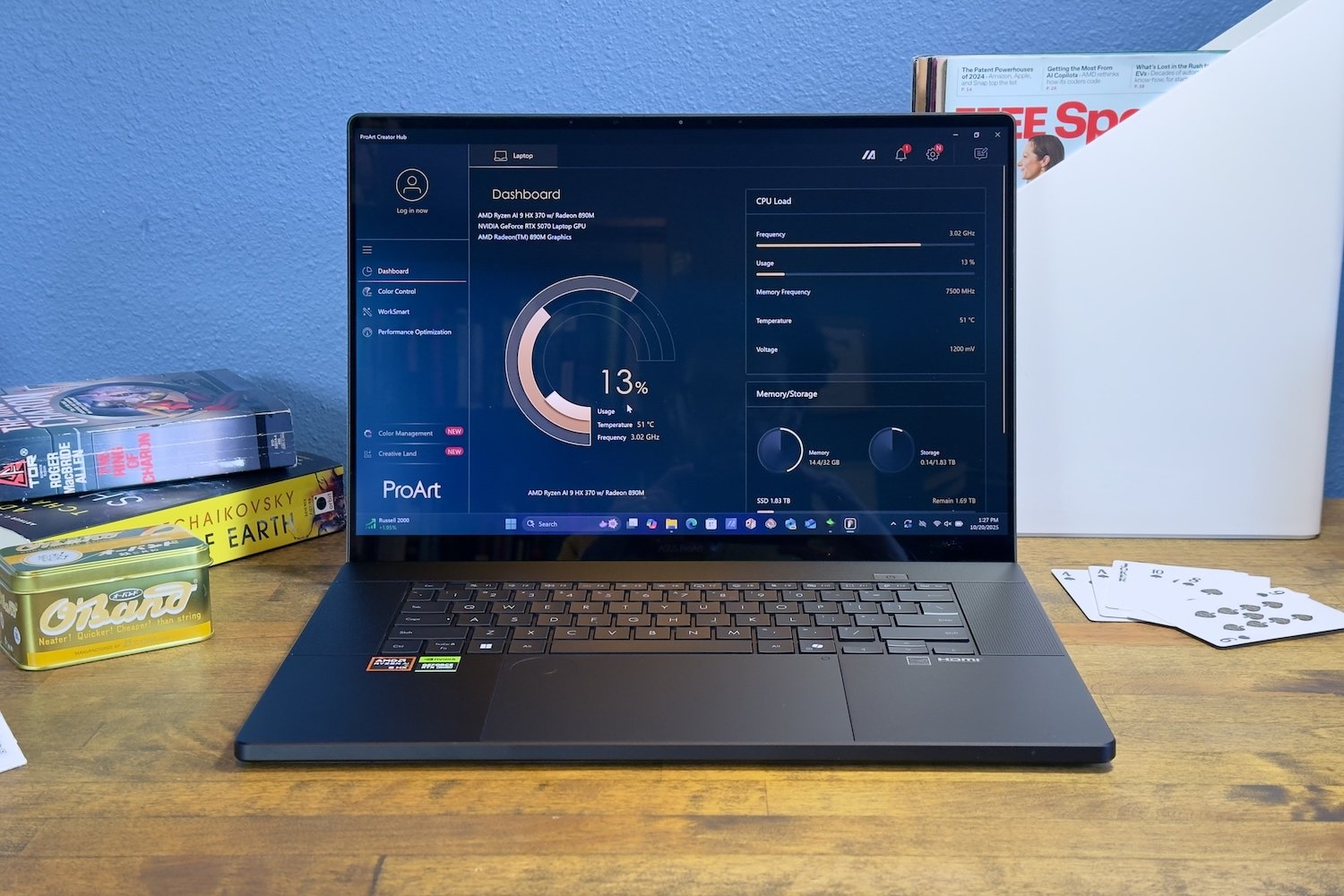At a glance
Expert’s Rating
Pros
- Well-rounded hardware configuration for the price
- Large touchpad with virtual dial
- Good balance of modern and legacy connectivity
- Strong battery life for a laptop with a discrete GPU
Cons
- Rigid and light chassis looks a bit mediocre
- Modest CPU and GPU performance
Our Verdict
The Asus ProArt P16 strikes a balance between portability and performance.
Price When Reviewed
This value will show the geolocated pricing text for product undefined
Best Pricing Today
Price When Reviewed
$2,399.99
Best Prices Today: Asus ProArt P16 (2025)
Asus ProArt P16 is a laptop that’s meant for creative professionals. Technically, just about any laptop with a fast CPU and GPU could do the job—and some pros turn towards gaming laptops for that reason. But the ProArt P16 seeks its niche by pairing performance with better battery life and a more compact chassis. Asus has to slightly reduce performance to make this possible, but the end result is alluring if you want a powerful Windows laptop that can also handle travel.
Asus ProArt P16: Specs and features as-tested
The Asus ProArt P16’s basic specifications are well-balanced and competitive with many mid-range laptops in the $2,000 to $3,000 price bracket. It pairs an AMD Ryzen AI 9 HX 370 processor with Nvidia RTX 5070 graphics, supported by 32GB of RAM and 2TB of solid state storage.
- Model number: H7606WP
- CPU: AMD Ryzen AI 9 HX 370
- Memory: 32GB LPDDR5-7500
- Graphics/GPU: Nvidia RTX 5070 8GB (105W TGP)
- NPU: Up to 50 TOPS
- Display: 16-inch 2880×1800 OLED 120Hz touchscreen
- Storage: 2TB M.2 PCIe 4.0 solid state drive
- Webcam and microphone: 1080p with dual microphone array
- Connectivity: 1x USB-C 4.0 40Gbps with Power Delivery and DisplayPort, 1x USB-C 3.2 10Gbps with Power Delivery and Display Port, 2x USB-C 3.2 10Gbps, 1x HDMI 2.1, 1x SD card reader, 1x 3.5 mm audio jack, 1x power connector
- Networking: Wi-Fi 7, Bluetooth 5.4
- Biometrics: Windows Hello facial recognition
- Battery capacity: 90 watt-hours
- Dimensions: 13.97 x 9.72 x 0.68 inches
- Weight: 4.08
- Operating System: Windows 11 Home
- Price: $2,399.99 MSRP
The model I reviewed is available for $2,399.99 at Best Buy. Asus also sells several alternative models with higher display resolutions and up to RTX 5090 graphics, as well as up to 64GB of memory. That will set you back $2,899.99. Alternatively, you can save a few hundred dollars with a $2,199.99 entry-level model that has RTX 4060 graphics and just 1TB of storage.
Asus ProArt P16: Design and build quality
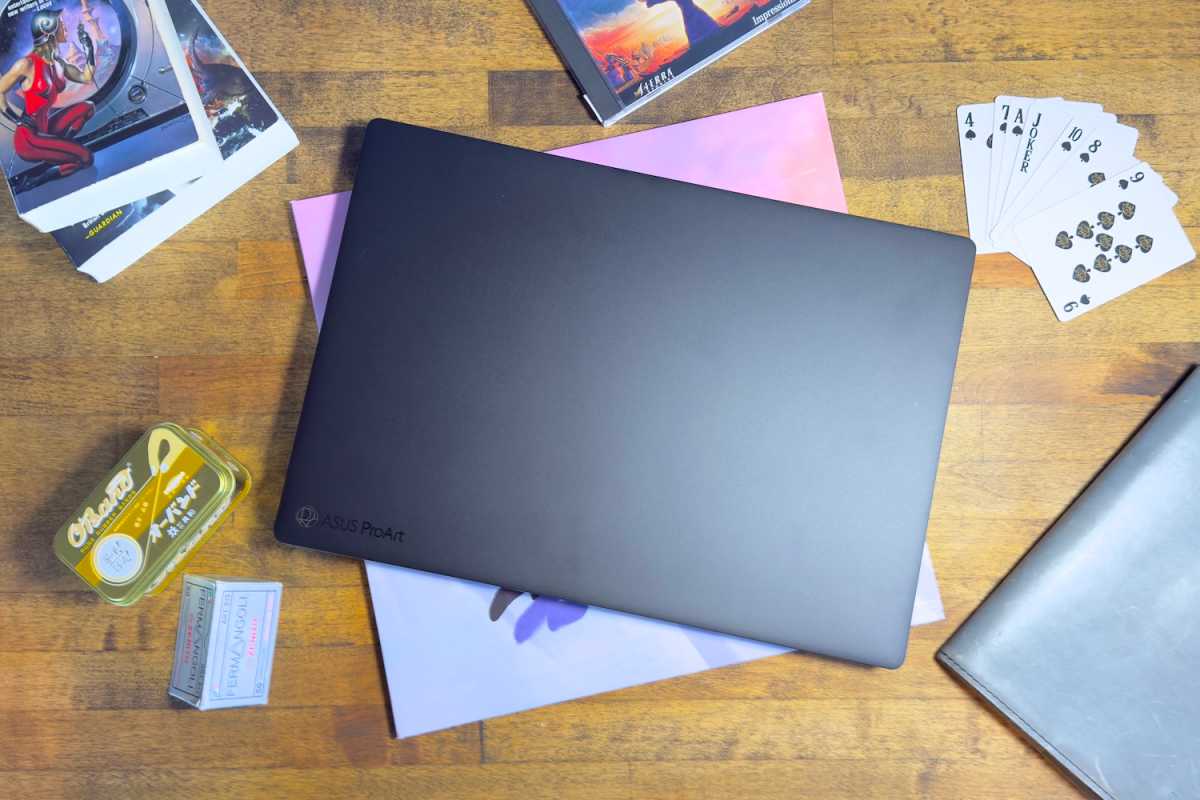
Foundry / Matthew Smith
The Asus ProArt P16 heard you like matte black, so it put matte black on your matte black so you can matte black while you matte black. The exterior, the key caps, the power button, the speaker grills, the touchpad, the little faux-dial are all matte black. Asus gets a little wild with the ProArt logo on the lid, though. It’s glossy black.
Personally, I think the laptop is a bit boring, but has it where it counts. Asus finishes the laptop’s metals with a subtle but noticeable metallic luster and the shade of black is wonderfully deep. Many laptops that are supposedly black (like Apple’s MacBook laptops) look slightly blue or gray compared to the ProArt P16.
The ProArt P16’s lower chassis, display lid, and keyboard deck all feel rigid when pressed or handled roughly. You’ll still find flex if you try, but the laptop is more than rigid enough to provide a luxurious, professional feel. There’s also a nice plastic lip around the display bezel. It’s a subtle element but should help keep dust and dirt out of the interior when the laptop is in your bag. Overall, the ProArt P16 is on par with top-end competitors like the Razer Blade 16 and Lenovo Yoga 9i.
It even resists fingerprints well enough. Some marks are inevitable, but a quick rub with a microfiber cloth will clean it up. I expect the palmrests and keyboard will show wear after a few months of heavy use, but the same is true for every darkly-colored laptop I’ve ever used.
Asus ProArt P16: Keyboard, trackpad, mouse
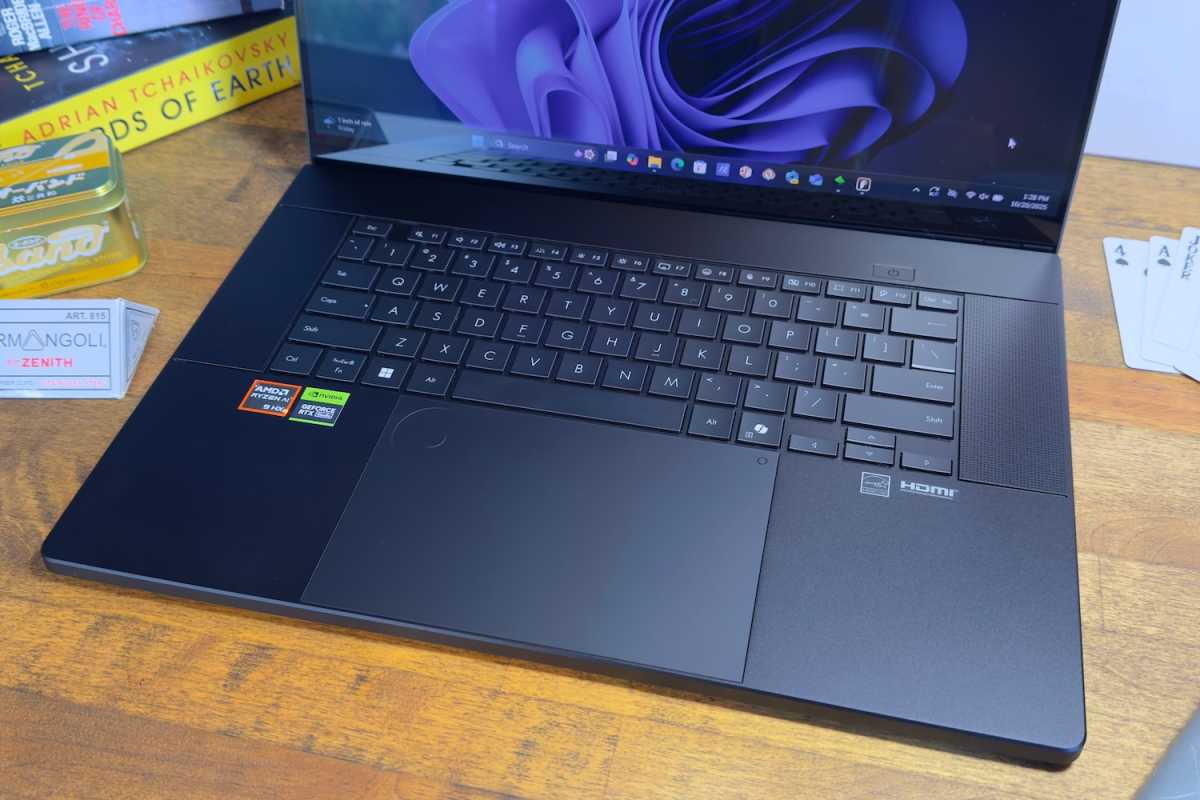
Foundry / Matthew Smith
Asus provides a spacious, centered keyboard layout without a numpad. The lack of numpad is notable, as this is a 16-inch machine and Asus could have found room. But the company instead elects to keep the keyboard centered for better typing ergonomics. The extra space on each side of the keyboard is used to provide large, user-facing speakers, which I’ll discuss shortly.
Key feel is good, if not exceptional. The keyboard offers good key travel and a smooth action that feels pleasant and doesn’t tire my fingers. Each key bottoms with a vague and subtle action, though. I prefer more tactile and audible feedback. Still, it’s a good keyboard.
Keyboard backlighting is standard, though it’s not great. The keys allow a lot of light leak from around the key caps, creating an uneven look, and the minimum brightness is higher than I like to see when typing in a dark room. Still, it ultimately does the job.
The touchpad, on the other hand, is a treat. It’s spacious, measuring about six inches wide and four inches deep, and provides a surface that’s smooth yet still just rough enough to provide a sense of tactile feedback.
It includes Asus’ dial control engraved in the upper left corner. This can be used in any situation where a dial might be handy, from scrolling down a page to adjusting exposure in a photo editing app. It lacks the reassuring tactile feel of a real dial, but it’s a feature unique to Asus’ ProArt, and certainly beats fiddling with sliders by clicking with the mouse cursor and then dragging them to and fro.
Asus ProArt P16: Display, audio
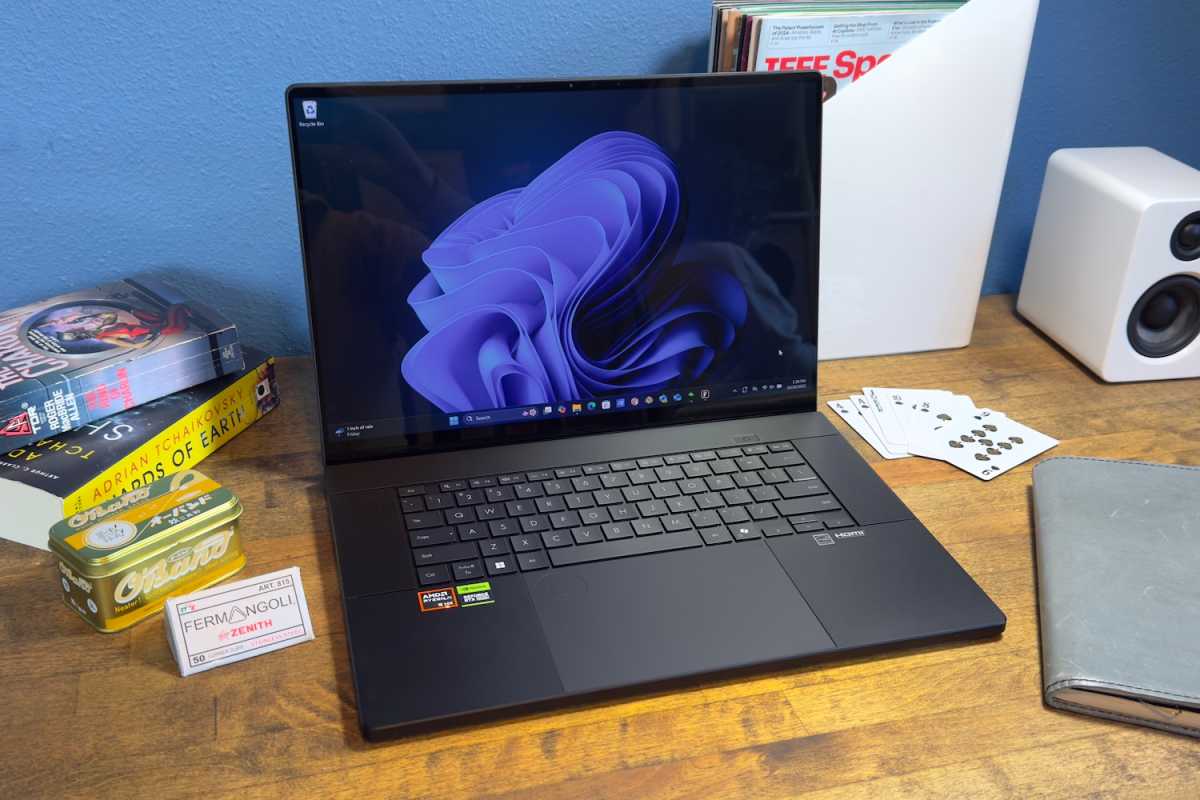
Foundry / Matthew Smith
The Asus ProArt P16’s display is a real treat. It’s a 16-inch OLED touchscreen with a 16:10 aspect ratio and 2,880 x 1,800 resolution. Like all modern laptop OLED displays, it provides incredible contrast and rich color.
It also goes the extra mile with a maximum brightness that exceeds 400 nits in HDR, which means the display doesn’t look overly dim in bright rooms (this can still be an issue with OLED displays in less expensive laptops). HDR is supported and offers decent brightness for a laptop. The display is extremely glossy, though, so you can expect mirror-like reflections from any light source sitting behind you.
The refresh rate maxes out at 120Hz, which provides great motion clarity while scrolling rapidly through a video timeline or document and also, of course, looks superb in games. The display doesn’t support G-Sync, though, so you’ll have to use V-Sync in games to ensure smooth frame pacing.
Interestingly, the OLED display on the ProArt P16 I reviewed is actually different from many other configurations sold by Asus. Most ProArt P16 models have an even higher display resolution of 3,840 x 2,400, but a lower refresh rate of 60Hz. Personally, I prefer an OLED display with a lower resolution and higher refresh rate. Still, creators who want to be able to see a full 4K image at its proper resolution should be wary and purchase a model with the display that meets their needs.
While the display is very good, it’s not an advantage. Nearly all mid-range to high-end Windows laptops now have an OLED display. And since they’re all supplied by Samsung, they all tend to offer similar performance.
The ProArt P16 provides user-facing speakers on each side of the keyboard. They offer good audio volume and a crisp presentation in most situations. The speakers do produce a hint of bass, but they become muddy in bass-heavy music when listening at maximum or near maximum volume. Still, the speakers are above-average for a laptop.
Asus ProArt P16: Webcam, microphone, biometrics
A 1080p webcam and dual microphone array are tucked into the Asus ProArt P16. The webcam provides solid video quality, though it’s nothing amazing by modern standards. It’s suitable for video conferences, but the image can still look grainy in dark lighting. The dual microphones pick up quality audio and are able to cancel out moderate, repetitive background noises. The webcam and microphone are competent, but par for the course in this price bracket.
The webcam doesn’t provide a physical privacy shutter. An electronic webcam disconnect is available, though, and can be selected with a keyboard shortcut.
Biometric login is available through Microsoft’s Windows Hello facial recognition. I generally prefer this to a fingerprint reader, and a fingerprint reader is not available on the ProArt P16. The facial recognition is speedy, reliable, and works in both dark and bright rooms.
Asus ProArt P16 : Connectivity
Asus has the ProArt P16’s connectivity dialed in. It includes one USB 4 port with up to 40Gbps of data, plus a USB 3.2 port with up to 10Gbps of data. Both are USB-C ports that provide DisplayPort and Power Delivery to charge the laptop, though be warned they don’t provide enough power to charge the laptop at full speed or prevent the battery from discharging at full load. Still, they provide a good range of options for connecting to a hub, dock, or USB-C monitor.
Thunderbolt is absent, however, as is often the case with laptops that have AMD inside. I don’t think this is a major issue, but shoppers should note that a laptop with Thunderbolt 5 can achieve even higher data rates of up to 80Gbps. That might be a factor if you often move very, very large files between your laptop’s storage and external storage.
The two USB-C ports are paired with two USB-A 3.2 ports, each with 10Gbps of data. There’s also HDMI 2.1, an SD Express card reader, and a 3.5mm combo audio jack. These ports give the ProArt P16 a good range of options that will have particular appeal to photographers and videographers. The HDMI-out is great for connecting to a variety of media devices and the SD Express card reader removes the need to carry a hub or adapter.
On the whole, I think the ProArt P16’s connectivity strikes the right balance of connectivity for most people. A MacBook Pro 16 has more high-speed Thunderbolt / USB-C connectivity, but it lacks USB-A. Other high-end consumer and prosumer laptops, like the Dell 16 Premium and Lenovo Yoga 9i 16, rely almost entirely on Thunderbolt / USB-C for connectivity.
Wireless connectivity includes Wi-Fi 7 and Bluetooth 5.4, which are the latest versions of each wireless standard. Most competitive laptops also support Wi-Fi 7 and Bluetooth 5.4, but it’s good to see Asus didn’t skimp here.
Asus ProArt P16: Performance
The Asus ProArt P16 comes in a variety of configurations, but all the current 2025 models, including the one that I reviewed, have an AMD Ryzen AI 9 HX 370. That is paired with up to Nvidia RTX 5090 graphics, but the more affordable model I tested stuck to the RTX 5070. 32GB of LPDDR5X-7500 memory and a 2TB PCIe 4.0 solid state drive round out the specifications.
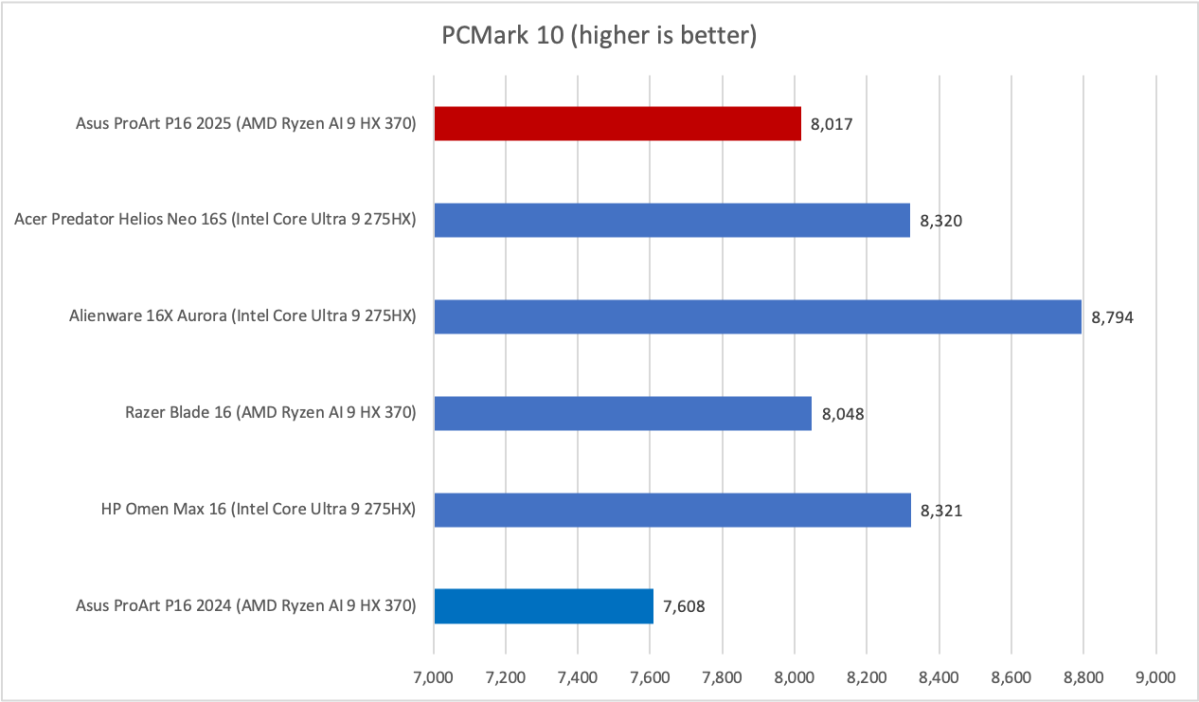
Foundry / Matthew Smith
We start with PCMark 10, a holistic system benchmark, where the Asus ProArt P16 scored 8,017. That’s an improvement over the 2024 model, which scored 7,608. However, the ProArt P16 is still towards the bottom half of this pack. It basically ties the Razer Blade 16, which scored 8,048, but ends up a few hundred points behind other 16-inch gaming and workstation laptops PCWorld has reviewed this year.
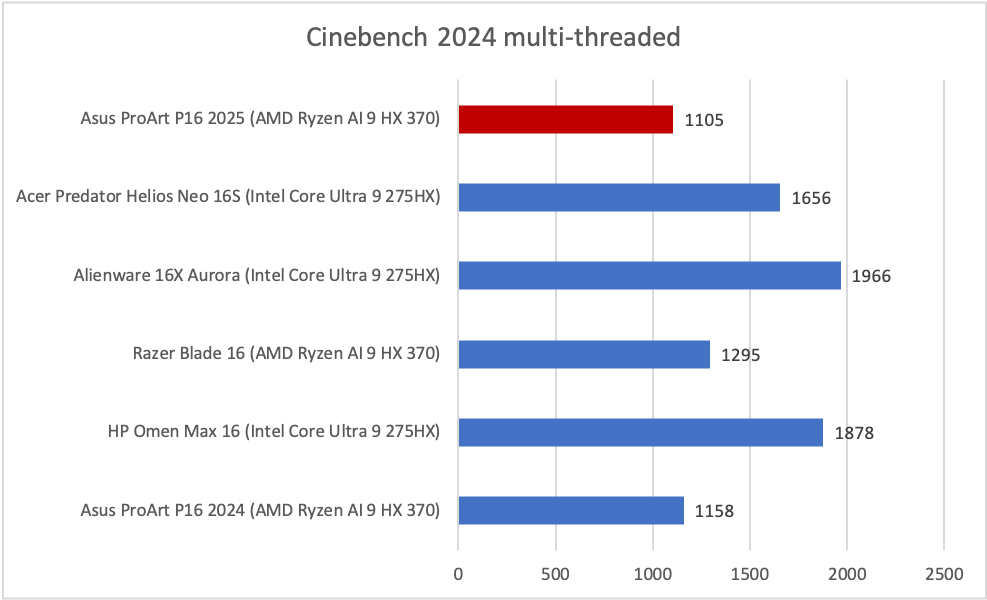
Foundry / Matthew Smith
Next up is Cinebench 2024 where, perhaps unsurprisingly, the new Asus ProArt P16 doesn’t outperform last year’s model. That’s unsurprising because they both have the same AMD Ryzen AI 9 HX 370 processor inside.
As the graph makes clear, Intel’s Core Ultra 9 is undoubtedly a better performer in heavily multithreaded tasks. All of the Intel powered laptops leave the AMD alternatives in the dust.
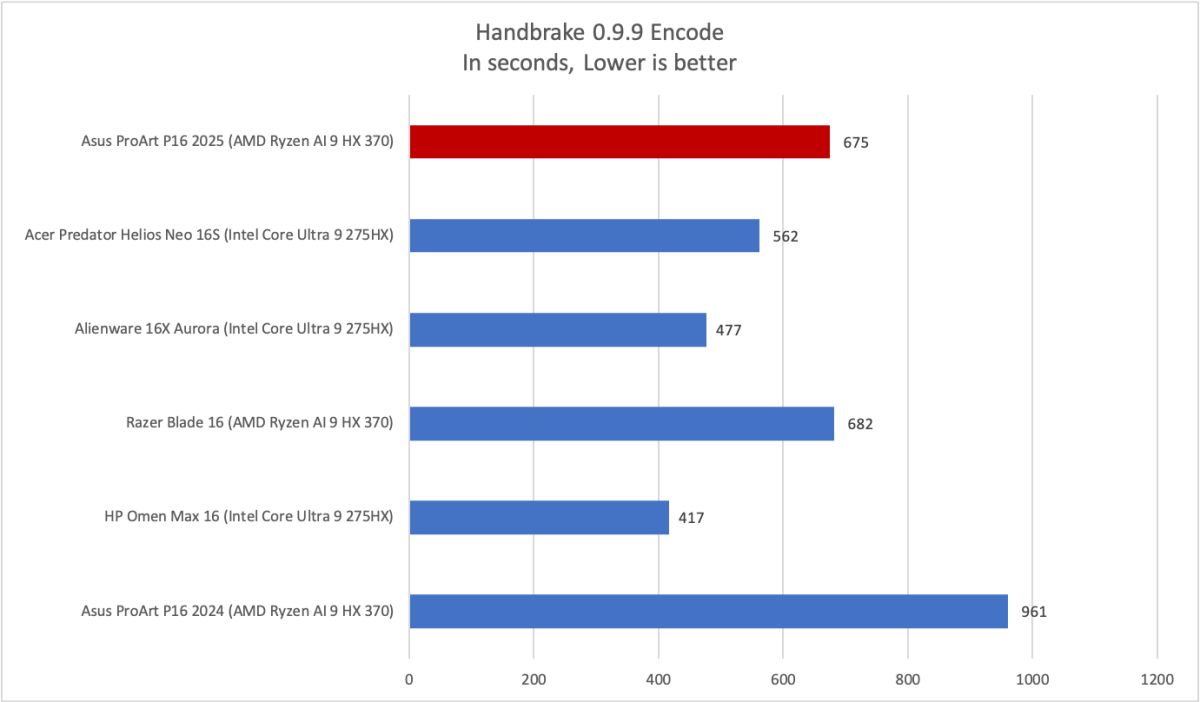
Foundry / Matthew Smith
It’s the same story in Handbrake. The laptops with AMD Ryzen AI 9 chips are slower than the Intel alternatives. Still, the new Asus ProArt P16 can at least keep up with latest Razer Blade 16 in this test, which is good to see.
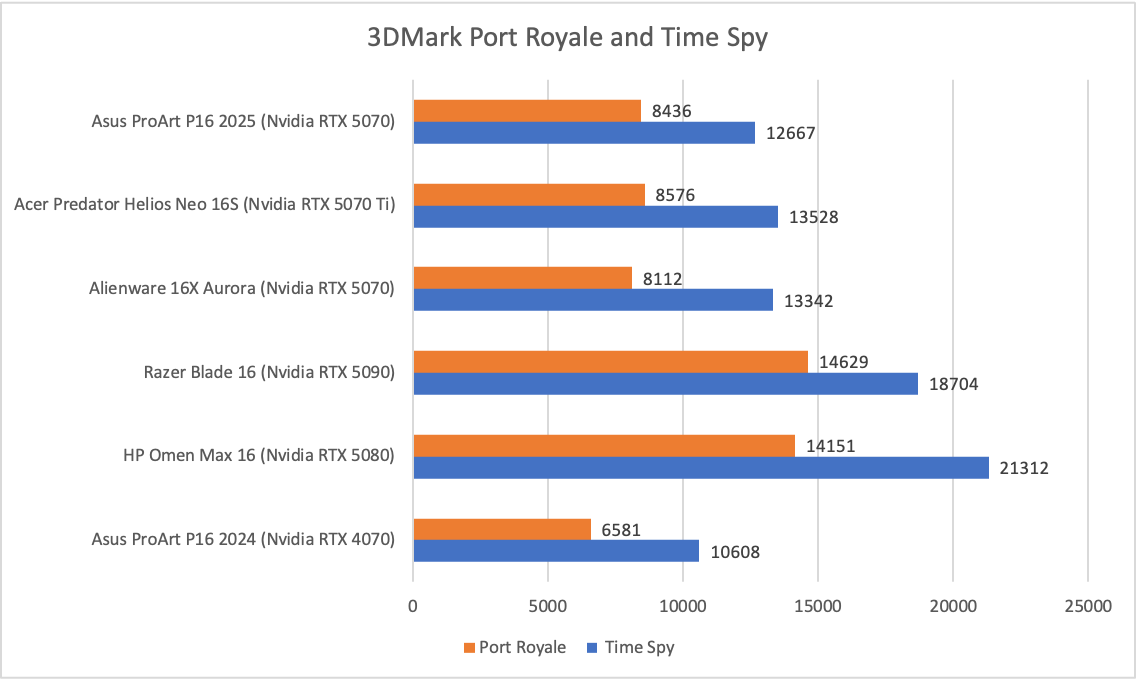
Foundry / Matthew Smith
CPU performance doesn’t seem to be the Asus ProArt P16’s forte, so what about the GPU? Well, there’s good news and bad news.
The good news is that the Asus ProArt P16 with RTX 5070 sees a healthy boost over last year’s model with the RTX 4070. The 3DMark Time Spy and Port Royale scores increase by roughly 20 percent.
However, the Asus ProArt P16 is still towards the lower end of the performance that can be expected from an Nvidia RTX 5070 mobile GPU. The ProArt P16 is a relatively slim and light laptop for a Windows machine with discrete graphics and that seems to throttle its performance.
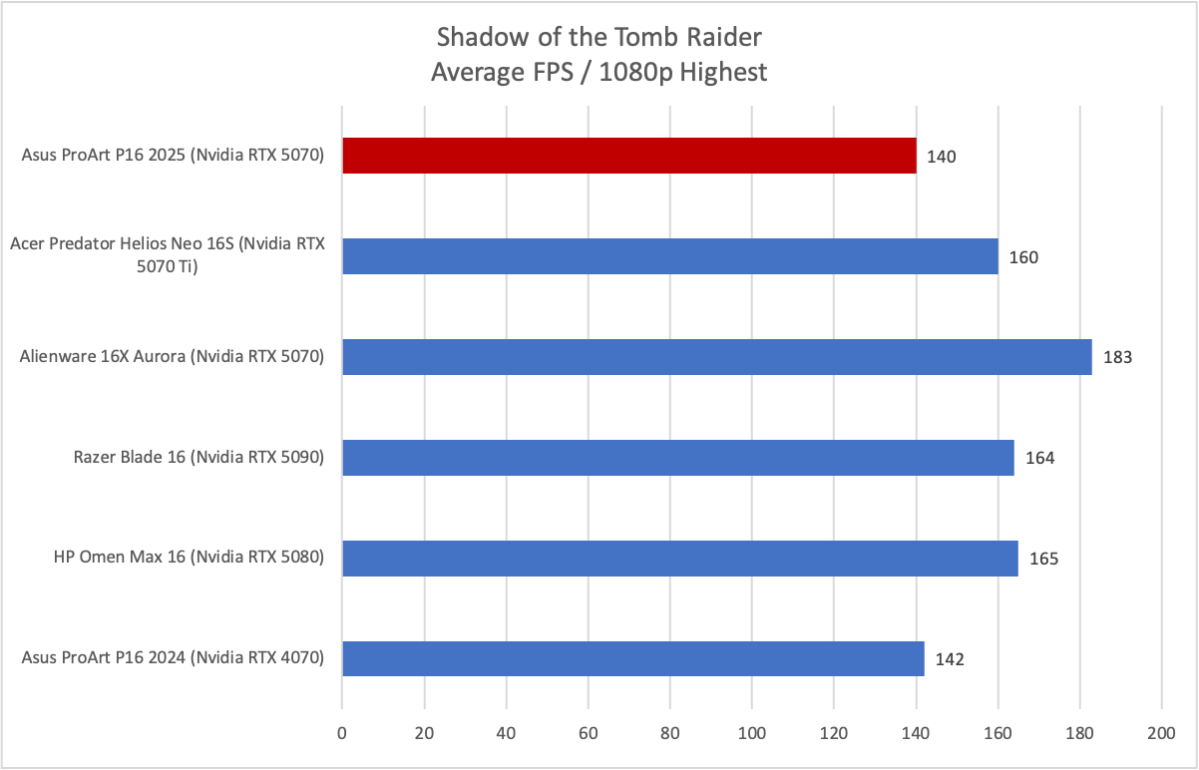
Foundry / Matthew Smith
Next up is Shadow of the Tomb Raider, an older title that most modern laptop GPUs can handle without much trouble. The RTX 5070 in the Asus ProArt P16 is no exception with an average of 140 frames per second.
However, it’s not any quicker than last year’s model, and a bit behind other RTX 5070 laptops we’ve recently reviewed.
The CPU may be a factor here: both the Acer Predator Helios Neo 16S and Alienware 16X have the Intel Core Ultra 9 275HX.
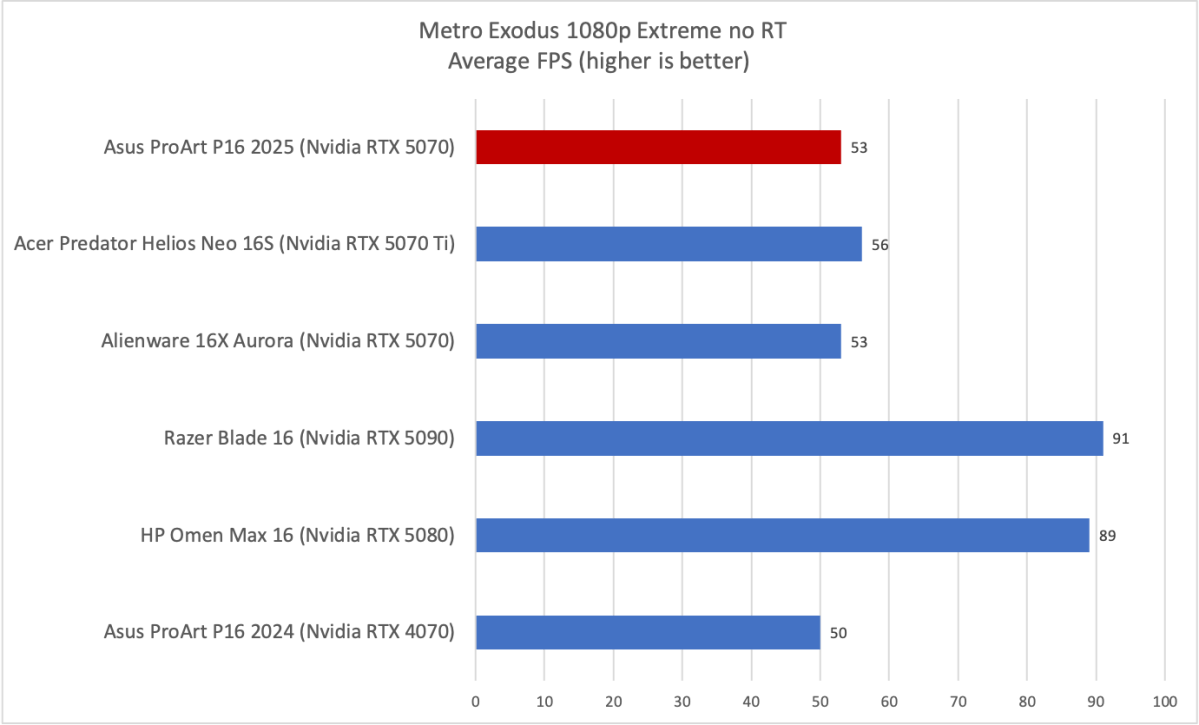
Foundry / Matthew Smith
Metro Exodus is a more demanding title when played at the Extreme preset. The Acer ProArt P16 averages 53 frames per second here, a slight increase from the prior year’s model, and more competitive compared to other RTX 5070 laptops.
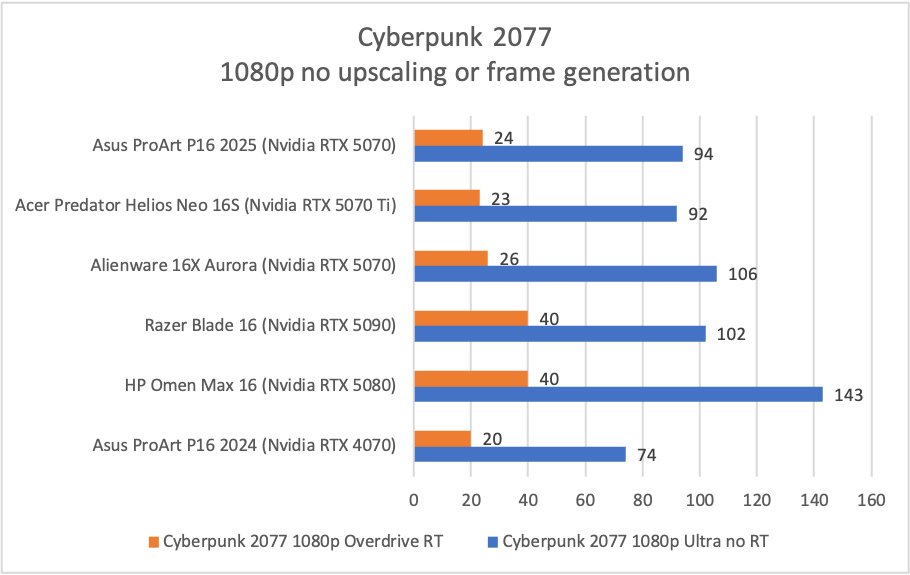
Foundry / Matthew Smith
We finish things off with Cyberpunk 2077, which speaks favorably of the Asus ProArt P16. The 2025 model with the RTX 5070 sees a major improvement over the 2024 model with RTX 4070. The average frame rate is boosted from 74 to 94 when playing at 1080p with the Ultra preset and no ray tracing in use.
The Overdrive ray traced preset is still more than Asus ProArt P16 can handle, which is to be expected. None of the RTX 5070 laptops do well in that extremely demanding workload. Keep in mind, though, that Overdrive is a real system-killer, and we are not using DLSS or FSR in our testing. Sticking to a lower ray traced preset and engaging DLSS will result in a perfectly playable experience.
It’s a laptop that can easily hit 60 FPS in Cyberpunk 2077 at Ultra detail settings, but also lasts up to 10 hours on a charge—and there aren’t many Windows laptops that manage that in 2025.
Overall, the Asus ProArt P16’s performance is decent but not exceptional. The AMD Ryzen AI 9 HX 370 remains behind the Intel Core Ultra 9 275HX in mutlithreaded CPU benchmarks. The P16’s graphics performance is also healthy but in some situations lags behind thicker, beefier machines with the same GPU. That’s not too surprising, as a thicker chassis often allows space for improved cooling.
Asus ProArt P16: Battery life and portability
The Asus ProArt P16 is portable for a 16-inch laptop. It measures a tad under seven-tenths of an inch thick and weighs a few ounces over four pounds. It’s compact for its display size, too, so it should fit in most backpacks designed for a 15-inch laptop. You can find more portable laptops, like those in the LG Gram series, but the ProArt P16 weighs less than a Razer Blade 16 or MacBook Pro 16.
A 90 watt-hour battery powers the laptop, which is a typical size for a laptop with discrete graphics. The laptop tries to make the most of the battery with a switchable graphics solution that can turn off the Nvidia GPU when its performance isn’t required.
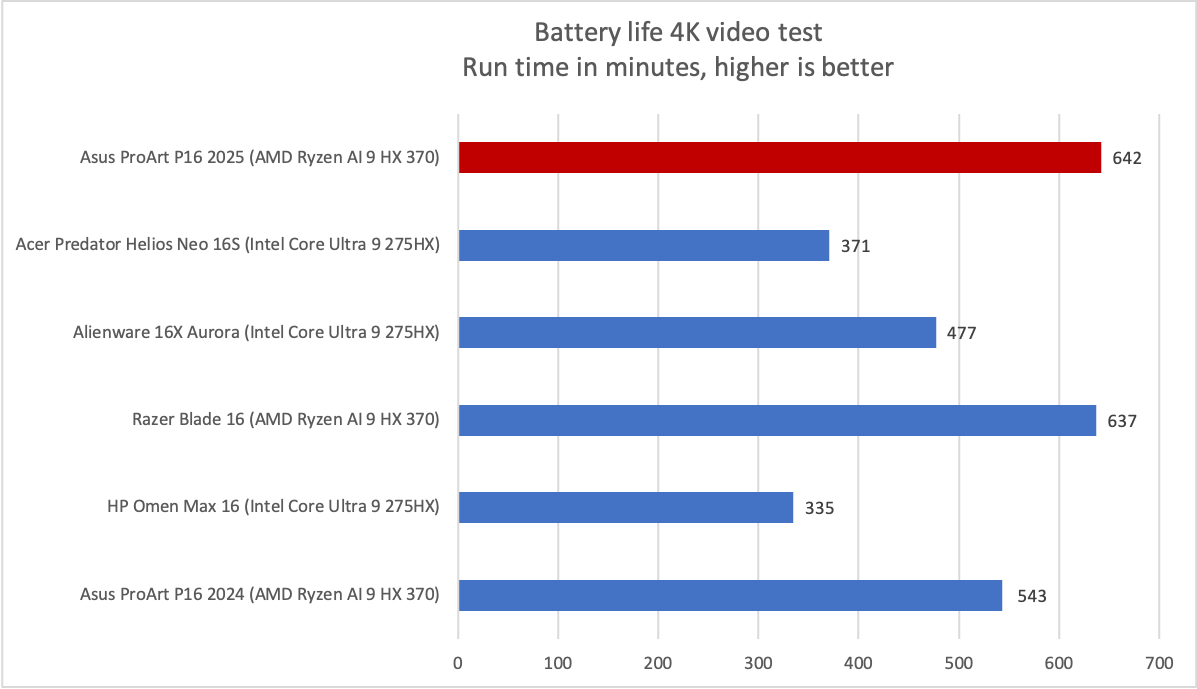
Foundry / Matthew Smith
That works to the Asus ProArt P16’s favor. The laptop managed to reach 10 hours and 42 minutes in our standard battery test, which loops a 4K file of the short film Tears of Steel. This is a light-load test, but my subjective experience showed the laptop’s real-world battery life is often close to that number. I saw eight to nine hours of battery life in a mix of web browsing, document editing, and photo editing.
These results aren’t going to beat Apple’s MacBook Pro 16, of course, but they’re good for a Windows laptop with discrete graphics and a capable CPU. The ProArt P16 compares well to other laptops that provide similar performance.
AMD also deserves credit here. The AMD Ryzen AI 9 HX 370 doesn’t hold a candle to the Intel Core Ultra 9 275HX in multi-core CPU workloads, but it’s more miserly about power consumption. The Intel-powered alternatives posted far less impressive battery life results.
When it comes time to recharge, you’ll need to connect the beefy 200-watt power adapter over a proprietary power connection. USB-C charging is possible, but the charging speed will be reduced, and USB-C won’t supply enough power to charge the laptop while you’re using it for a demanding task (like gaming or heavy video editing).
Asus ProArt P16: Conclusion
The Asus ProArt P16 is a laptop that delivers what it was designed to deliver.
It’s expected to provide the performance required for more demanding workloads, from 4K video editing to modern PC games. Yet it must also be portable enough for travel.
Balancing these competing priorities means the ProArt P16 must give up performance when compared to bulkier alternatives. But it also means the ProArt P16 provides a better balance of portability and performance. It’s a laptop that can easily hit 60 FPS in Cyberpunk 2077 at Ultra detail settings, but also lasts up to 10 hours on a charge—and there aren’t many Windows laptops that manage that in 2025.
This articles is written by : Nermeen Nabil Khear Abdelmalak
All rights reserved to : USAGOLDMIES . www.usagoldmines.com
You can Enjoy surfing our website categories and read more content in many fields you may like .
Why USAGoldMines ?
USAGoldMines is a comprehensive website offering the latest in financial, crypto, and technical news. With specialized sections for each category, it provides readers with up-to-date market insights, investment trends, and technological advancements, making it a valuable resource for investors and enthusiasts in the fast-paced financial world.
